Toward the city come hills
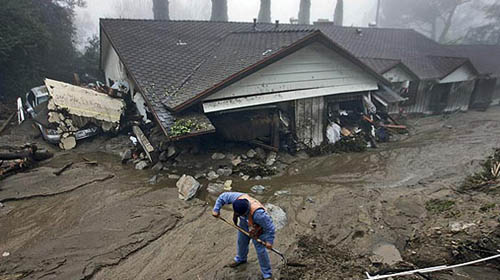
[Image: Mudslides strike Los Angeles; photo by Gary Friedman for the L.A. Times].
In his short novel Man in the Holocene, author Max Frisch describes the psychological implications of living in the presence of possible Alpine landslides. The idea that the very earth beneath your feet might someday start to avalanche takes on existential overtones.
"Nobody in the village," Frisch writes, for instance, "thinks that the day, or perhaps night, will come when the whole mountain could begin to slide, burying the village for all time." He then supplies us with the image of a "laborer who has been working all his life on supporting walls and does not believe the whole mountain could ever begin to slide"; for someone such as that, a landslide's accompanying loss of foundation is simply too extraordinary to think about.
Somewhere in the hills, though, Frisch suggests, is a hidden logic: it both explains and demonstrates how thousands of tons of rocks and the spaces between them can unlock, breaking open into discrete geometries to tumble toward the valleys below, perhaps bringing houses—whole cities—down with them.
And it can all start with a minor act: a small crack, perhaps a rainstorm, perhaps just the weight of one man hiking alone. "That is the way landslides begin, cracks appearing noiselessly, not widening, or hardly at all, for weeks on end, until suddenly, when one is least expecting it, the whole slope below the crack begins to slide, carrying even forests and all else that is not firm rock down with it," Frisch writes.
Indeed, "One must be prepared for everything."
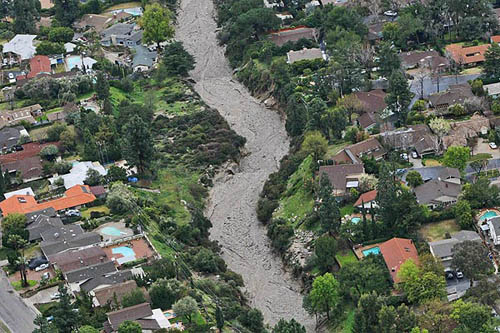


[Images: Beneath the pavement, liquid terrain. All photos by Anne Cusack for the L.A. Times].
A few months ago, meanwhile, I bookmarked a short article in the L.A. Times. Published after massive wildfires had burned through the hills around the city, denuding them of all vegetation and thus destabilizing the rock and soil, the article reported on a number of city residents in the outlying hilltop communities who had begun to eye the slopes around them with alarm. It was as if the earth itself had been weaponized: every hill, scarred by fire now and insecure for void of plantlife, was a mudslide waiting to happen.
To protect against this cascading eventuality, a new municipal landscape architecture thus emerged: mazes of concrete barriers and walls of sandbags showed up to redivide the streets. Circulation through the neighborhood would be entirely redefined, and a massive landscape of waiting would be installed: a space patient for all the material locked inside those hills to arrive.
- Officials have said the concrete barriers [they soon installed] will stay in place for three to four years because the hillsides are completely barren in the wake of the Station fire, which charred more than 160,000 acres. It was the worst wildfire in L.A. County's history. Many measures had been put in place, including the clearing of debris basins, the notification of residents in high-risk areas, the distribution of sandbags and the laying of several thousand feet of K-rails.
It was a "Niagara of mud," the L.A. Times reported.

[Image: Photo by Irfan Khan for the L.A. Times].
"The mudflow twisted garage doors into dented accordions," we read, and it "disintegrated walls of sandbags and knocked over 4,000-pound concrete barriers that lined the road to divert water away from homes. About 25 vehicles were damaged, flowing down the street and smashing against walls, trees and one another." In one case, "a white single-story home appeared submerged in several feet of dirt, looking as if a giant child had dropped the house in a sand pit."
Another man, woken up in his Snover Canyon house in the middle of the night, looked outside to see "muddy water carrying boulders the size of bowling balls... through the 4-foot-high barricade of sandbags, a plywood wall and a chain-link fence. A sheet of mud nearly a half-foot deep and 16 feet wide cascaded across the backyard."
- He ran to the bathroom window. He had expected this. It was the weak point of his defense. There at the corner of the yard, a geyser of water crashed into the remains of the wall and shot into the air. He had to get his family out. He didn’t know what else might be coming down that mountain.
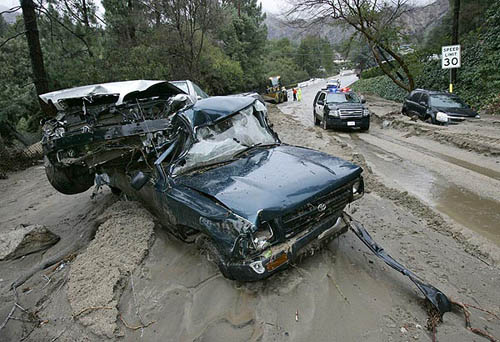
[Image: Photo by Irfan Khan for the L.A. Times].
Once the mudslides abated in one district, "nine homes in the foothill area suffered enough damage to be red-tagged, which means they’re partially collapsed and uninhabitable. With crumbling walls, sunken roofs, shattered windows and mud-filled living rooms, the structures are in a precarious position," themselves now more like residual appendages of the debris flow than freestanding architectural units.
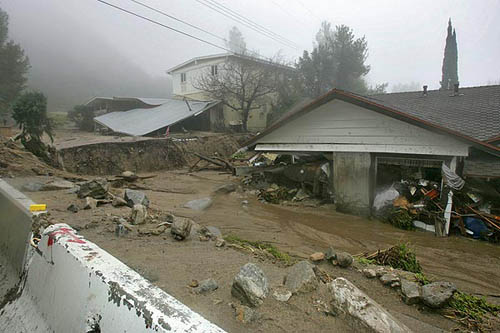
[Image: Photo by Irfan Khan for the L.A. Times].
However, perhaps the best article ever written about mudslides in Los Angeles was produced nearly 30 years ago by John McPhee. Called "Los Angeles Against the Mountains," it was originally published in The New Yorker but was later collected in McPhee's genuinely excellent and very highly recommended book The Control of Nature.
Among many other things, McPhee devotes several paragraphs to a description of the DIY architectural tweaks that have arisen in response to these landscapes-gone-mobile. "At least one family," he writes, for instance, "has experienced so many debris flows coming through their back yard that they long ago installed overhead doors in the rear end of their built-in garage. To guide the flows, they put deflection walls in their back yard. Now when the boulders come they open both ends of their garage, and the debris goes through to the street."
Not only has this image stuck with me for years now, ever since I first read McPhee's book, but it has also been impossible for me to avoid thinking about when looking at the photographs you see here, particularly those taken on the mud-slicked streets themselves by Irfan Khan. But the very idea that one could deliberately open a causeway for the natural world to flow, with awe-inspiring violence, through one's own personal space—that you could actually build a kind of sacrifice zone within your own house for forces otherwise well beyond spatial control—is, at the very least, an extraordinary metaphor for living with the natural world.
This minor architecture—of repurposed overhead doors, emergency ditching, concrete crib structures, deflection walls, and more—brings the ever-present possibility of geologic collapse into world of design.
After all, how do you build on an earth that keeps disappearing?
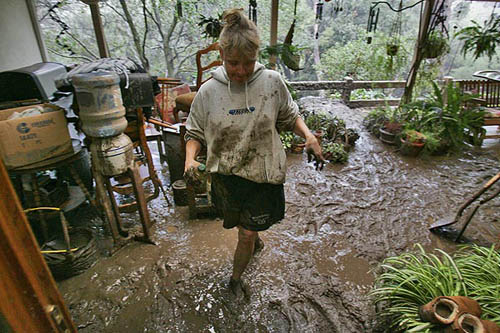
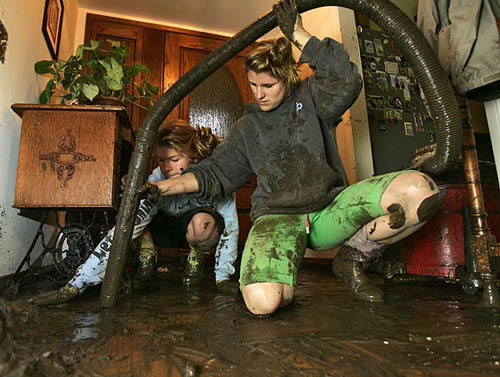
[Images: Photos by Irfan Khan for the L.A. Times].
Returning to Frisch's book, there is a fantastic, if brief, image of sound being put to use to stimulate minor avalanches, perhaps as a way to help avoid the Big One later on. "Men blow three times on a little horn and wave a red flag," Frisch writes, as if describing a fairy tale of precisely administered sonic land-disassembly, "and shortly afterward the bits come rattling down, pebbles and gravel from the Ice Age."
I mention this out of the possibility that perhaps Los Angeles city officials should not be responding to the ever-present threat of landslides on the urban perimeter with hardened architectural defenses but with something more like preemptive techniques: why wait for the hills to come to you, in other words (see this diagram of how debris basins work), when you could simply bring them down on your own time and schedule, in rock-by-rock increments, pulling rivers of solid geology out from their halo'd terraces above the city? Could micro-landslides somehow keep apocalyptic avalanches at bay?
Or, more realistically, does L.A. need to ditch the bulky mazes of concrete switching walls and go for a massive replanting effort, instead? Like Beijing's Great Green Wall against the coming desert, L.A. needs to plant a wall of minor roots against the instability of its mountains.





Comments are moderated.
If it's not spam, it will appear here shortly!
I'm pretty surprised that official people thought mere concrete barricades would be of any use against mudslides. They have a penchant for sweeping away everything. The Times article contains this winning quote, though...
P. Michael Freeman, chief of the L.A. County Fire Department, acknowledged that crews were operating on weather forecasts that turned out to be incorrect. "I think it's imperative that everybody understand the unpredictability of predictions," Freeman said.
Well, yes, of course.
The Control of Nature - one of my favourite McPhee books.
In addition to "ditching the bulky mazes of concrete switching walls" and planting a "green wall," L.A. should consider limiting residential development in the hills/ vulnerable areas.
I have just read an article about LA enforcing a new code mandating that all new buildings be built we storm water retention systems and being fine $13 per gallon for the water that flows off their property. This is the way to go storm water retention and more permeable landscaping are far more effective and easier to implement. Ideas like bio-swales and on-site storm water storage and treatment are far cheaper and better solutions then trying to rebuild after a land slide or relocating residents. As usual people need to think proactively. Maybe when the installation of such systems is cheaper then the insurance premiums( which I am sure it is getting close) we will see some action on this front.
I understand the speed of mudslides can get quite high, up to 80 km/h depending on a number of factors, but they can be quite slow moving also, and there is something quite terrifying about the gradual enroachment over our houses, our belongings, ourselves, by an unremitting, yet sedate flow of mud - the suffocation... perhaps it stems from childhood fears of quicksand, or the scene in Neverending Story when Atreyu tries to save Artax from the swamp of sadness...
The McPhee book was the first thing that came to my mind as I started reading this piece. Glad you mentioned it, as I was trying to remember the title. It's amazing to me how people continue to live in those hillside areas, many of them fully aware of what can happen to their homes (and obviously many more who are totally unaware).
Post a Comment